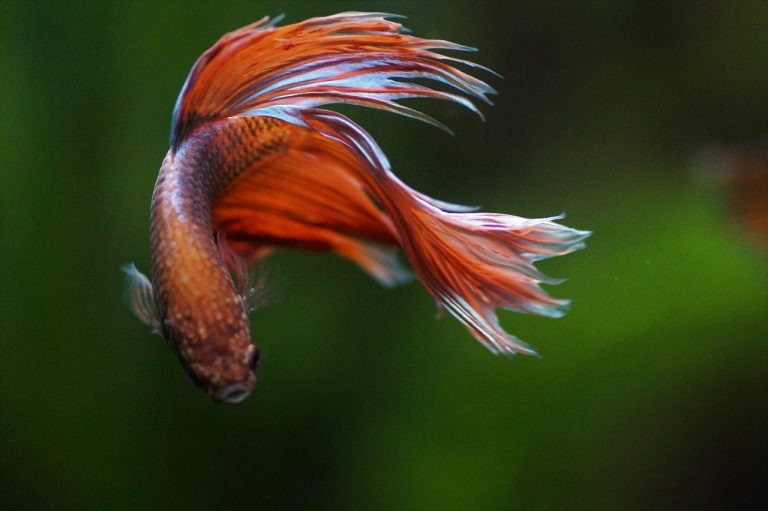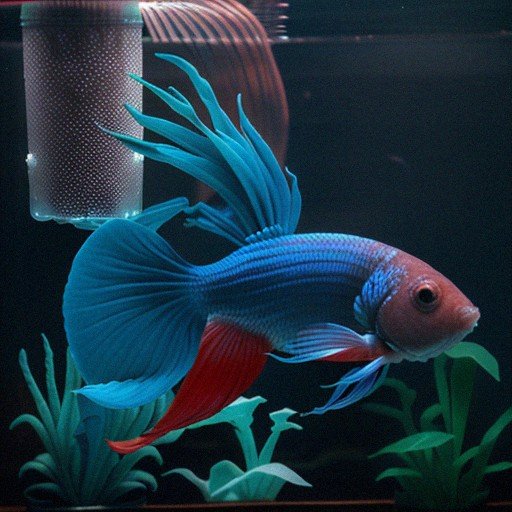Tail biting in betta fish is an issue that perplexes many first-time owners, who may find themselves confronted with this self-harming behavior without clear recourse.
As custodians of these vibrant aquatic individuals, it is essential to comprehend the underlying causes of tail biting, which often stem from environmental and psychological stressors.
The freedom for bettas to thrive in captivity is contingent upon our ability to provide a conducive habitat that mirrors the complexity and richness of their natural ecosystem.
This brief exploration will delve into the multifaceted nature of tail biting, elucidating the common triggers and outlining practical solutions.
By adjusting aquarium conditions, enhancing mental stimulation, and implementing preventative measures, owners can establish a harmonious environment that promotes the well-being and natural liberty of their betta companions.
Key Takeaways
- Tail biting in Betta fish is a self-injurious behavior caused by environmental factors that do not meet the fish’s needs for space and stimulation.
- Inadequate tank conditions, loneliness or overcrowding, and lack of mental stimulation contribute to tail biting.
- Providing a habitat with ample enrichment, such as plants and hideaways, can mitigate loneliness without overcrowding and offer the mental stimulation necessary to curtail self-destructive behavior.
- Regular monitoring and maintenance of water parameters and tank conditions are essential in preventing stress-induced behaviors.
Understanding Tail Biting Behavior
Tail biting in Betta fish is a self-injurious behavior characterized by a fish nipping at its own tail. It is a phenomenon that perplexes many first-time Betta owners. This behavior is a sign of distress and can be identified by specific behavioral indicators and distinctive bite patterns on the caudal fin.
The behavior of tail biting is often precipitated by environmental factors that do not align with the species’ intrinsic needs for space and stimulation. These factors can include inadequate tank size, lack of hiding places, or a lack of mental stimulation. When these needs are not met, Betta fish may resort to tail biting as a way to cope with the stress.
Bite patterns on the tail can provide valuable information about the severity and frequency of the tail biting episodes. These bite patterns can manifest as jagged or rounded sections missing from the tail. By examining these patterns, Betta owners can better understand the extent of the self-harming behavior and the level of distress experienced by the fish.
Understanding the indicators of tail biting in Betta fish is crucial for formulating an intervention that respects the Betta’s natural inclinations and fosters a habitat conducive to its well-being and freedom from stress-induced self-harm. By addressing the underlying environmental factors and providing the necessary space, hiding places, and mental stimulation, Betta owners can help prevent and alleviate tail biting behavior in their fish.
Identifying Common Stressors
Several primary stressors contribute to tail biting in Betta fish, including inadequate tank conditions, loneliness or overcrowding, and lack of mental stimulation.
Water parameters such as pH, temperature, and ammonia levels must be meticulously monitored and maintained within specific ranges to prevent stress. Even slight deviations can provoke adverse behaviors, including tail biting.
Furthermore, Betta fish are often territorial, and unsuitable tank mates can trigger aggressive responses or stress-induced self-mutilation. Careful selection of compatible species and ensuring sufficient space for each inhabitant are crucial.
To mitigate loneliness without overcrowding, providing a habitat with ample enrichment—such as plants and hideaways—can offer the mental stimulation necessary to curtail this self-destructive behavior, promoting both physical health and psychological well-being.
Assessing Aquarium Conditions
Upon setting up an aquarium, it is crucial for owners to critically evaluate water quality, space, and environmental enrichment to prevent tail biting in Betta fish. Meticulously maintaining optimal conditions mitigates the risk of stress-induced behaviors such as self-mutilation. Betta fish require a harmonious habitat that fosters their health and well-being.
- Water Quality: Ensure that parameters such as temperature, pH, ammonia, nitrite, and nitrate levels are within the acceptable range to promote a stress-free environment.
- Space: Provide a tank that affords ample room for swimming and territorial behaviors, minimizing frustration and aggression.
- Tank Companions: Choose tank mates cautiously, as incompatible species can elevate stress, leading to tail biting.
Empower Betta fish to thrive by upholding a sanctuary that caters to their instinctual and physiological needs.
Enrichment and Mental Stimulation
An often overlooked aspect of Betta fish care is providing sufficient enrichment and mental stimulation to prevent tail biting due to boredom or frustration. Research in aquatic animal behavior suggests that environmental complexity is critical in promoting psychological well-being in fish.
Interactive toys, such as floating logs or mirror treatments, can engage Betta fish in their natural behaviors, potentially reducing stress-induced self-mutilation.
Additionally, incorporating hiding places like caves or densely planted areas not only emulates their native habitat, fostering a sense of security, but also encourages exploration, a vital component of cognitive stimulation.
Strategically introducing these elements into the Betta fish environment can significantly diminish the incidence of tail biting by catering to their intrinsic need for a dynamic and interactive living space.
Treatment and Prevention Strategies
The treatment and prevention of tail biting in Betta fish require a multifaceted approach that includes both immediate care and long-term environmental management. To ensure the well-being of Betta fish, one must consider the intricate interplay between Betta genetics and environmental factors.
Addressing nutritional deficiencies is also paramount in preventing tail biting behavior.
- Optimize Tank Conditions: Implement a consistent water quality regimen, focusing on parameters ideal for Betta health, and avoiding stressors known to trigger tail biting.
- Enhance Diet: Provide a balanced diet rich in essential nutrients to rectify any nutritional deficiencies that could contribute to tail biting.
- Assess Genetics: Select Betta fish from breeders who prioritize robust genetic lines, thereby reducing the predisposition to self-harm.
Adopting these evidence-based strategies can significantly mitigate the risk of tail biting in Betta fish, promoting freedom from this detrimental behavior.





